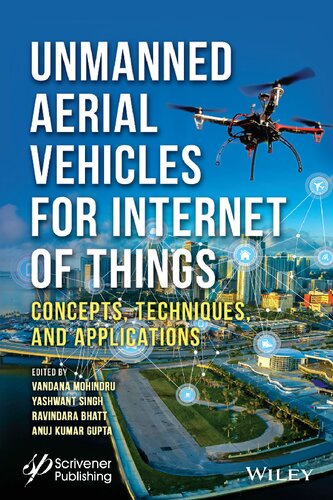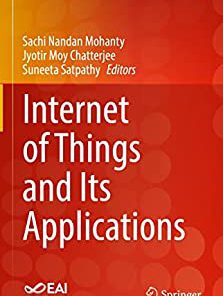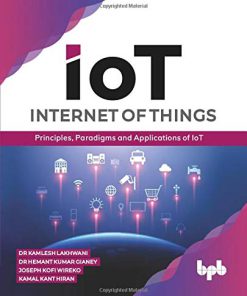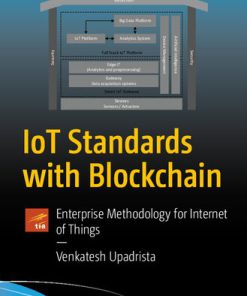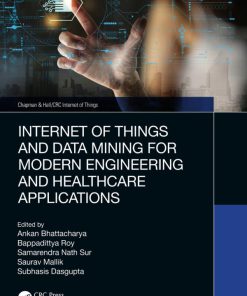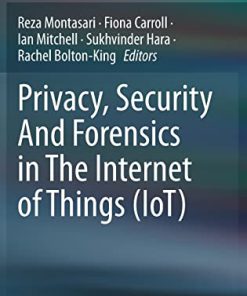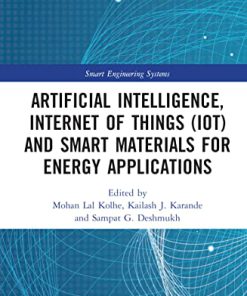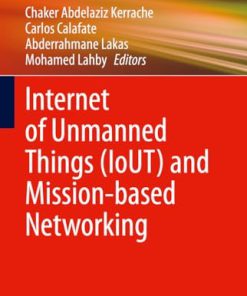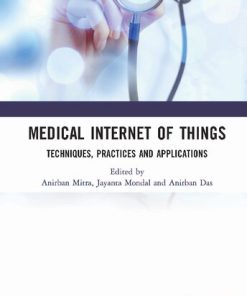Unmanned Aerial Vehicles for Internet of Things Concepts Techniques and Applications 1st Edition by Vandana Mohindru, Yashwant Singh, Ravindara Bhatt, Anuj Kumar Gupta ISBN 1119769159 9781119769156
$50.00 Original price was: $50.00.$25.00Current price is: $25.00.
Unmanned Aerial Vehicles for Internet of Things: Concepts, Techniques, and Applications 1st Edition by Vandana Mohindru, Yashwant Singh, Ravindara Bhatt, Anuj Kumar Gupta – Ebook PDF Instant Download/Delivery: 1119769159, 9781119769156
Full download Unmanned Aerial Vehicles for Internet of Things: Concepts, Techniques, and Applications 1st Edition after payment
Product details:
ISBN 10: 1119769159
ISBN 13: ISBN13
Author: Vandana Mohindru, Yashwant Singh, Ravindara Bhatt, Anuj Kumar Gupta
Unmanned Aerial Vehicles for Internet of Things: Concepts, Techniques, and Applications 1st Edition: UNMANNED AERIAL VEHICLES FOR INTERNET OF THINGS
This comprehensive book deeply discusses the theoretical and technical issues of unmanned aerial vehicles for deployment by industries and civil authorities in Internet of Things (IoT) systems.
Unmanned aerial vehicles (UAVs) has become one of the rapidly growing areas of technology, with widespread applications covering various domains. UAVs play a very important role in delivering Internet of Things (IoT) services in small and low-power devices such as sensors, cameras, GPS receivers, etc. These devices are energy-constrained and are unable to communicate over long distances. The UAVs work dynamically for IoT applications in which they collect data and transmit it to other devices that are out of communication range. Furthermore, the benefits of the UAV include deployment at remote locations, the ability to carry flexible payloads, reprogrammability during tasks, and the ability to sense for anything from anywhere. Using IoT technologies, a UAV may be observed as a terminal device connected with the ubiquitous network, where many other UAVs are communicating, navigating, controlling, and surveilling in real time and beyond line-of-sight.
The aim of the 15 chapters in this book help to realize the full potential of UAVs for the IoT by addressing its numerous concepts, issues and challenges, and develops conceptual and technological solutions for handling them. Applications include such fields as disaster management, structural inspection, goods delivery, transportation, localization, mapping, pollution and radiation monitoring, search and rescue, farming, etc. In addition, the book covers:
- Efficient energy management systems in UAV-based IoT networks
- IoE enabled UAVs
- Mind-controlled UAV using Brain-Computer Interface (BCI)
- The importance of AI in realizing autonomous and intelligent flying IoT
- Blockchain-based solutions for various security issues in UAV-enabled IoT
- The challenges and threats of UAVs such as hijacking, privacy, cyber-security, and physical safety.
Audience: Researchers in computer science, Internet of Things (IoT), electronics engineering, as well as industries that use and deploy drones and other unmanned aerial vehicles.
Unmanned Aerial Vehicles for Internet of Things: Concepts, Techniques, and Applications 1st Edition Table of contents:
1. Unmanned Aerial Vehicle (UAV): A Comprehensive Survey
- 1.1 Introduction
- 1.2 Related Work
- 1.3 UAV Technology
- 1.4 Application of UAV
- 1.5 UAV Challenges
- 1.6 Conclusion and Future Scope
- References
2. Unmanned Aerial Vehicles: State-of-the-Art, Challenges and Future Scope
- 2.1 Introduction
- 2.2 Technical Challenges
- 2.3 Conclusion
- References
3. Battery and Energy Management in UAV-Based Networks
- 3.1 Introduction
- 3.2 The Need for Energy Management in UAV-Based Communication Networks
- 3.3 Efficient Battery and Energy Management Proposed Techniques in Literature
- 3.4 Conclusion
- References
4. Energy Efficient Communication Methods for Unmanned Aerial Vehicles (UAVs): Last Five Years’ Study
- 4.1 Introduction
- 4.2 Literature Survey Process
- 4.3 Routing in UAV
- 4.4 Challenges and Issues
- 4.5 Conclusion
- References
5. A Review on Challenges and Threats to Unmanned Aerial Vehicles (UAVs)
- 5.1 Introduction
- 5.2 Applications of UAVs and Their Market Opportunity
- 5.3 Attacks and Solutions to Unmanned Aerial Vehicles (UAVs)
- 5.4 Research Challenges
- 5.5 Conclusion
- References
6. Internet of Things and UAV: An Interoperability Perspective
- 6.1 Introduction
- 6.2 Background
- 6.3 Internet of Things (IoT) and UAV
- 6.4 Applications of UAV-Enabled IoT
- 6.5 Research Issues in UAV-Enabled IoT
- 6.6 High-Level UAV-Based IoT Architecture
- 6.7 Interoperability Issues in UAV-Based IoT
- 6.8 Conclusion
- References
7. Practices of Unmanned Aerial Vehicle (UAV) for Security Intelligence
- 7.1 Introduction
- 7.2 Military
- 7.3 Attack
- 7.4 Journalism
- 7.5 Search and Rescue
- 7.6 Disaster Relief
- 7.7 Conclusion
- References
8. Blockchain-Based Solutions for Various Security Issues in UAV-Enabled IoT
- 8.1 Introduction
- 8.2 Introduction to UAV and IoT
- 8.3 Security and Privacy Issues in UAV-Enabled IoT
- 8.4 Blockchain-Based Solutions to Various Security Issues
- 8.5 Research Directions
- 8.6 Conclusion
- 8.7 Future Work
- References
9. Efficient Energy Management Systems in UAV-Based IoT Networks
- 9.1 Introduction
- 9.2 Energy Harvesting Methods
- 9.3 Energy Recharge Methods
- 9.4 Efficient Energy Utilization Methods
- 9.5 Conclusion
- References
10. A Survey on IoE-Enabled Unmanned Aerial Vehicles
- 10.1 Introduction
- 10.2 Overview of Internet of Everything
- 10.3 Overview of Unmanned Aerial Vehicle (UAV)
- 10.4 UAV and IoE Integration
- 10.5 Open Research Issues
- 10.6 Discussion
- 10.7 Conclusion
- References
11. Role of AI and Big Data Analytics in UAV-Enabled IoT Applications for Smart Cities
- 11.1 Introduction
- 11.2 Overview of UAV-Enabled IoT Systems
- 11.3 Overview of Big Data Analytics
- 11.4 Big Data Analytics Requirements in UAV-Enabled IoT Systems
- 11.5 Challenges
- 11.6 Conclusion
- 11.7 Future Work
- References
12. Design and Development of Modular and Multifunctional UAV with Amphibious Landing, Processing and Surround Sense Module
- 12.1 Introduction
- 12.2 Existing System
- 12.3 Proposed System
- 12.4 IoT Sensors and Architecture
- 12.5 Advantages of the Proposed System
- 12.6 Design
- 12.7 Results
- 12.8 Conclusion
- 12.9 Future Scope
- References
13. Mind-Controlled Unmanned Aerial Vehicle (UAV) Using Brain–Computer Interface (BCI)
- 13.1 Introduction
- 13.2 Mind-Controlled UAV with BCI Technology
- 13.3 Layout and Architecture of BCI Technology
- 13.4 Hardware Components
- 13.5 Software Components
- 13.6 Hardware and Software Integration
- 13.7 Conclusion
- References
14. Precision Agriculture With Technologies for Smart Farming Towards Agriculture 5.0
- 14.1 Introduction
- 14.2 Drone Technology as an Instrument for Increasing Farm Productivity
- 14.3 Mapping and Tracking of Rice Farm Areas With ICT and Remote Sensing Technology
- 14.4 Strong Intelligence from UAV to the Agricultural Sector
- 14.5 Drones-Based Sensor Platforms
- 14.6 Jobs of Space Technology in Crop Insurance
- 14.7 The Institutionalization of Drone Imaging Technologies in Agriculture for Disaster Risk Management
- 14.8 Usage of IoT in Agriculture and UAV Applications
- 14.9 Conclusion
- References
15. IoT-Based UAV Platform Revolutionized in Smart Healthcare
- 15.1 Introduction
- 15.2 IoT-Based UAV Platform for Emergency Services
- 15.3 Healthcare IoT: Technologies and Advantages
- 15.4 Surgical and Medical Applications of Drones
- 15.5 Drones that Will Revolutionize Healthcare
- 15.6 Healthcare Revolutionizing Drones
- 15.7 Conclusion
People also search for Unmanned Aerial Vehicles for Internet of Things: Concepts, Techniques, and Applications 1st Edition:
unmanned aerial vehicle companies
an unmanned aircraft flyaway is considered a
what are unmanned aerial vehicles used for
unmanned aerial vehicle
unmanned aerial combat vehicle
Tags:
Vandana Mohindru,Yashwant Singh,Ravindara Bhatt,Anuj Kumar Gupta,Unmanned,Aerial Vehicles,Internet of Things,Techniques,Applications
You may also like…
Computers - Internet & World Wide Web
Computers - Computer Science
Internet of Things IoT Principles Paradigms and Applications of IoT English Edition Lakhwani
Computers - Networking
Computers - Security
Engineering - Engineering Technology
Engineering - Energy & Power Resources
Computers - Networking
Medicine
Medical Internet of Things: Techniques, Practices and Applications 1st Edition Anirban Mitra

